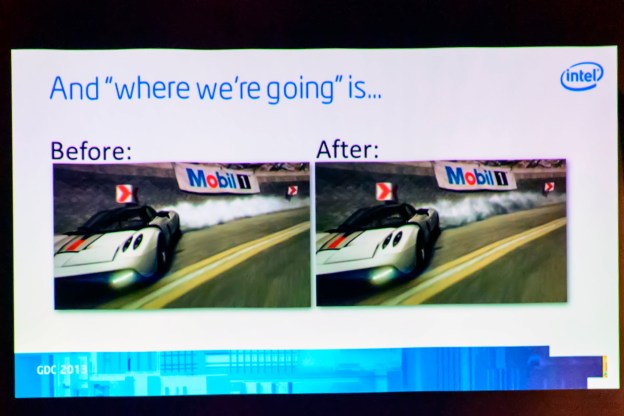 Richard Huddy has been around the block a few times, graphically speaking.
Richard Huddy has been around the block a few times, graphically speaking.
Huddy, who works with game developers for Intel’s graphics group, worked previously at both AMD and Nvidia in PC graphics. He now feels that Intel’s HD Graphics core can compete with higher end discrete graphics, particularly when Intel ships its fourth generation Core architecture processors, code-named Haswell. Haswell’s graphics will improve overall performance by at least 50% over the current Ivy Bridge generation, as well as bringing full DirectX 11.1 support to Intel’s GPU core.
Intel is making noises like the major graphics hardware developer it really is. Huddy talked up the statistics from Valve Software’s Steam online gaming service, pointing out that Intel HD Graphics cores make up 13-percent of all GPUs on Steam. And that number is climbing as more gamers flock to Ultrabooks and other thin and light laptops.
In previous generations of Intel graphics, developers needed to specifically optimize their game titles to even run on Intel’s graphics cores. Even then, the results would be minimalist graphics fidelity and relatively low frame rates. Ivy Bridge has begun to change that, with current generation games running at better frame rates, though detail levels are still modest.
With the next generation Haswell GPU, Intel is amping up its developer efforts, convincing some key developers to adopt a pair of extensions to Microsoft DirectX 11.1 programming interface. Most Windows games use DirectX as the main software interface for taking advantage of 3D graphics hardware. Starting with DirectX 11, Microsoft allows hardware vendors to incorporate extensions to DirectX.
Intel’s new extensions, dubbed InstantAccess and PixelSync, offer features that improve the efficiency of graphics that use memory shared with the CPU, something all integrated graphics do. InstantAccess allows the CPU to write data to memory allocated for the graphics cores, substantially improving performance when copying texture data to graphics memory. By the same token, InstantAccess allows the CPU to read data from the GPU memory, something that’s useful for applying post-processing effects like depth-of-field and motion blur.
PixelSync gives game programmers control over the order of operations when writing out pixels. That’s important for creating certain types of transparency and shadow effects. For example, CodeMasters will be using PixelSync in its upcoming GRID 2 racing game, enabling a graphics feature called AVSM (adaptive volumetric shadow maps). That big mouthful of words describes a technique which makes it possible for programmers to create more realistic smoke effects by allowing the smoke particles to properly self-shadow in large volumes. You can see this in the skidding car images from a beta version of the game.
In the image above, the left side shows the smoke from the skidding car without AVSM – it looks more like steam than smoke. The right side shows the internal shadows that realistic smoke particles generate.
Another game that will take advantage of the new techniques is the new Total War game from Creative Assembly, Total War: Rome II. Creative Assembly hopes to close the gap a bit between users running fourth generation HD Graphics and gamers with high end, discrete graphics cards.
Even current owners of Ivy Bridge based laptops may benefit somewhat, as Intel is about to release a driver update that improves both power efficiency and performance across the entire range of Intel HD Graphics. Driver 15.31 is launching with a better balance between CPU and GPU utilization as well as full support for OpenCL 1.2 GPU compute capability.
Haswell-based Ultrabooks and laptops are slated to ship sometime in the second half of 2013. As users flock to these more mobile, attractive PC platforms, they’ll still want to use them for games. Haswell looks promising, but we won’t really know until those products arrive if Intel’s ambitious goals on the graphics front are real or if they’re just blowing virtual smoke.


